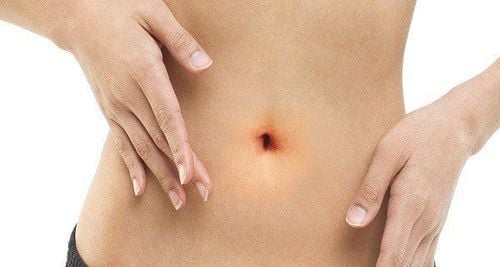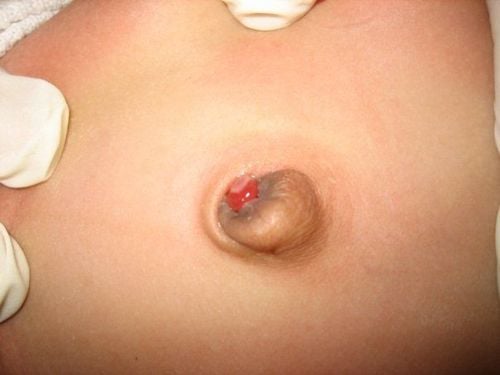This is an automatically translated article.
Newborns usually shed the umbilical cord after 7 to 10 days and after 15 days, the umbilical cord is completely healed. Currently, experts recommend that it should be left open, without the need for a tight bandage, but must pay attention to monitor, use an antiseptic for the umbilicus for newborns, and take proper care to keep the baby's navel clean and dry. and promptly detect when there are abnormalities, prevent umbilical infection.
1. When to use umbilical cord antiseptic for newborns?
Care and sterilization of the umbilical cord and the area around the umbilical cord for babies should be done 1 to 2 times per day in children:
Newborns who have not shed the umbilical cord Children who have lost the umbilical cord but still have discharge Children with inflammation navel, navel infection
2. How to properly disinfect the umbilical cord for a newborn
Equipment to prepare:
70 degree alcohol disinfectant solution, 0.9% NaCl physiological saline Sterile gauze Sterile cotton swabs Steps:
Step 1. Caregivers wash their hands with water and soap, then can be disinfected with alcohol 70 degrees to prevent bacteria, viruses from entering the baby's navel area Step 2. Remove the umbilical cord (if any) and gently lift the umbilical cord with sterile gauze Step 3. Observe the umbilical cord foot, the umbilical cord body, the umbilical section and the skin around the navel, check for abnormalities such as pus discharge, redness, swelling, swelling or not. Notice if the baby's navel has a bad smell. Step 4. Use sterile gauze or cotton swabs impregnated with an antiseptic solution in the following order: umbilical foot, umbilical cord body, umbilical cord clamp, umbilical cord cross section. Step 5. Disinfect the surrounding skin from the inside out, 5-7cm wide around the navel. Step 6. Wrap the diaper area below the navel, avoid letting urine or other dirt get on the cleaned navel area.
3. Note when using umbilical cord antiseptic for babies
Mothers should use 70 degrees alcohol solution or 0.9% NaCl physiological saline solution to disinfect the baby's umbilical cord daily. In the case of infants with umbilical cord infections, a 1% solution of Milian or Eosin, also known as red medicine, can be applied to the baby's navel 3-4 times a day, 1-2 drops each time. Take care not to let the solution get into the mucous membranes or eyes of the child. After each use, close the lid tightly, store in a cool, dry place, out of reach of children.
Betadine 5% solution with Povidone Iodine ingredient is a commonly used wound antiseptic in hospitals. However, Betadine solution is contraindicated for use in infants and children under 2 years of age.
In case the mother does not know and has used Betadine to disinfect the umbilical cord for her baby, depending on the method of use, there will be different treatments. If the mother pours the solution on sterile gauze or sticks and disinfects the baby's umbilical cord once a day, just stop using it, replace it with a 70-degree alcohol solution or physiological saline to clean the baby's umbilical cord and do not need to use it. take the child to the doctor. If mothers disinfect by applying directly to the baby's navel or using it 2 or more times a day, more than 2 drops each time, they need to take the child to the doctor to check the thyroid endocrine function.
Betadine solution is an antiseptic used to clean the perineal suture but has little effect on the neonate due to low concentrations of absorption and excretion in breast milk. However, pregnant and lactating women, children under 6 months of age should limit their use, unless directed by a doctor.
4. Notes when disinfecting the umbilical cord for babies
Keep the navel and surrounding skin clean and dry until the umbilical cord falls off Should remove the umbilical cord clamp after 48 hours if the umbilical cord is dry Leave the navel open to help the umbilicus dry faster and easier to fall off Take care of the umbilical cord 1 to 2 times per day days or when the navel is dirty Limit touching and touching the umbilical cord and the skin around the umbilicus to avoid infection and inflammation of the umbilicus Continue to care for the umbilical cord after the umbilical cord has fallen off, until the umbilical cord is dry and no longer secretes In case the umbilical cord falls off late (after 15 days), the common causes are: Umbilical infection: mothers need to clean and disinfect the umbilical cord more times; Umbilical buds or umbilical cord tissue: Dip a solution of silver nitrate daily or consult a doctor for electrocautery if the umbilical cord is large. Absolutely do not apply antibiotic dots on the navel area unless directed by your doctor.
5. Abnormalities that need to take the child to the doctor
During the process of cleaning and disinfecting the baby's umbilical cord, if mothers observe the following abnormalities, they should immediately take the child to see a doctor.
Baby navel bleeding heavily or difficult to stop bleeding Umbilical oozing yellow, pus-filled or foul-smelling umbilical umbilicus persists after falling off The skin around the navel is red and swollen, the baby is fussy, uncomfortable, and sucks poorly The umbilicus has buds umbilical cord seed or granule tissue, prolonged oozing The umbilicus slows down after 2 weeks Newborns are very sensitive, so the use of any medicine should be taken care of and prescribed by a specialist doctor, parents Do not arbitrarily use umbilical cord antiseptic for infants to avoid side effects affecting the child.
Please dial HOTLINE for more information or register for an appointment HERE. Download MyVinmec app to make appointments faster and to manage your bookings easily.













